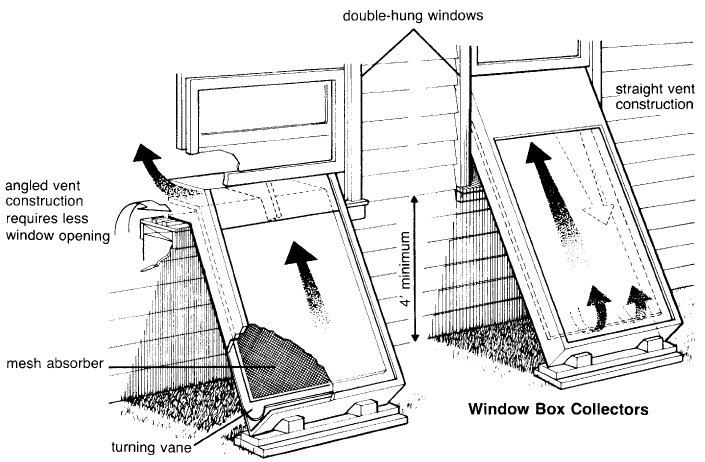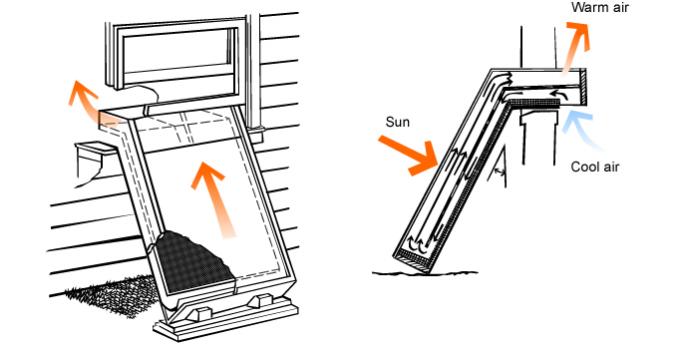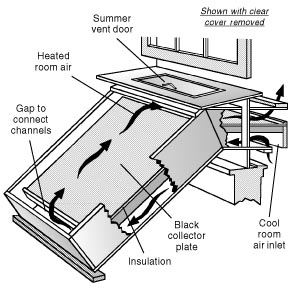You can build your own solar heater!
Good Day everyone. A think today I’m want to go back over our last discussion, that was Solar heating . With some simple plans on how to build your own solar heater and inexpensive materials that anybody can use to build there own solar heater Contrary to what you may know about installing a solar heating system it really isn’t that difficult, or expensive. You can research online your self there are plenty of ideas on the subject. I reviewed many solar collector concepts over the years and I found a few that were really easy to build and use.
The cost could be as low as $150 to $400 for a one time investment to build it yourself. (for those of you that are not that handy you could still buy a solar heater for about $800 to $1500) that one time investment will pay for itself in less than few short months.
Not only will you be enjoying free energy, but you will have less of a carbon footprint .
To some people that’s more important than saving money.
Solar air heating comes in many different varieties and is surprisingly very efficient! One manner of heating air with the sun is by using collector plates which absorb the radiating heat from our star, heats the air inside of the collector, and uses this air to heat a closed space. You can either buy a system or you can build one yourself! This is an extremely simple technology to implement and this article is going to show you how to build one for yourself!
The benefits of this technology are impressive:
Cheaper or near non-existent heating bills
If the grid goes out you still have heat
Very simple to build with little to no upkeep needed
Possible to fit directly into existing central air systems
Solar hot air collector plates come in two types: Passive Direct Gain or Active Direct Gain. Here, the term “direct gain” is used to describe the solar collector itself which receives it’s heat by the sunlight which shines directly onto it. These are two of the many terms developed to describe solar thermal technologies which have been implemented in more recent decades.
For a solar collector, to be passive means to have no fans which circulate the air through it. When using a passive solar collector it must be installed vertically to be effective with an inlet at the bottom and an outlet at the top. Due to the change in temperature inside of the collector air will always suction from the bottom, warm as it rises and be forced into the space to be heated. This simple convection current technology requires no machinery whatsoever and is effective at reducing reliance on grid energy.



The solar heater I built was very similar to the ones in these diagrams.^
In all cases these are the key features:
- Frame – The frame is typically made of 1 x 6 or 2 x 6 lumber. The interior depth is usually about 3 to 4 inches depending on construction.
- Insulated Back – This is where most of the heat can be lost. 1 to 2 inches of Polyisocyanurate is recommended. Side insulation is a bit less important.
- Matte Black Interior – All interior surfaces should be painted with a heat tolerant matte black paint to absorb as much of the sun’s heat as possible.
- Solar absorber – This is the heart of the unit.The absorber collects the heat which is transferred to air travelling across and through the heated surfaces.
- Air intake/outlet – Cooler air enters the unit (usually at the bottom) and after picking up the heat from the absorber, exits the top of the unit. This happens either through a natural process (Thermosiphoning) or assisted by a thermostatically-controlled fan.
- Glazing – The front of the unit is sealed with clear material to allow the sun to shine on the solar absorber and build up the interior temperature. Typical glazing materials are polycarbonate (Lexan or twin wall type), acrylic, or tempered glass.
Solar absorber
 All else being equal, the solar absorber material and airflow within the "box" is where the designs below differ.This can have a big impact on the efficiency and effectiveness of the unit as a whole. Finding the right combination of heat gain and air throughput may require a bit of experimentation. A solar heater that can move a lot of 120F air is more effective than 160F air moving too slowly. High interior temperatures lead to much more heat loss through the glazing. Fan speed and duct size will affect the air flow.
All else being equal, the solar absorber material and airflow within the "box" is where the designs below differ.This can have a big impact on the efficiency and effectiveness of the unit as a whole. Finding the right combination of heat gain and air throughput may require a bit of experimentation. A solar heater that can move a lot of 120F air is more effective than 160F air moving too slowly. High interior temperatures lead to much more heat loss through the glazing. Fan speed and duct size will affect the air flow.
The designs described below do not show the fan, which is usually located on the outlet end to pull air through the unit. It’s recommended to provide a flap of some sort to automatically close off the outlet when the interior temperature of the unit drops below room temperature to avoid reverse siphoning of warm air into the unit. A layer of lightweight plastic works well to seal the opening if the outlet has some hardware cloth over it. Although these units are shown tilted to face the sun, they can be installed vertically in northern latitudes as well.
Back-pass Type The back-pass collector has been around for a long time and there are a few variations in designs. The basic idea is that the air is heated as it moves upwards behind the heated solar absorber. Alternating baffles may be added to slow or disrupt the airflow to increase the heat transfer.
The back-pass collector has been around for a long time and there are a few variations in designs. The basic idea is that the air is heated as it moves upwards behind the heated solar absorber. Alternating baffles may be added to slow or disrupt the airflow to increase the heat transfer.
Some window-mounted back-pass systems allow cool interior air to enter through an isolated chamber at the back.The air gains heat as it rises, travelling behind the solar absorber. The absorber may also be situated to allow air to travel on both sides for more surface contact.The heated air exits from the top of the unit.
Double Screen Type The screen collector is another common type that’s frequently used and it’s the easiest and least expensive to build.The black mesh screen provides lots of contact surface for transferring heat to the moving air, while adding very little resistance to the air flow. In most instances, the screen is tilted within the box so the screen is closer to the glazing at the top of the unit. A layer of black window screen can be stapled to each side of a wooden frame and mounted within the box.
The screen collector is another common type that’s frequently used and it’s the easiest and least expensive to build.The black mesh screen provides lots of contact surface for transferring heat to the moving air, while adding very little resistance to the air flow. In most instances, the screen is tilted within the box so the screen is closer to the glazing at the top of the unit. A layer of black window screen can be stapled to each side of a wooden frame and mounted within the box.
In the tests that we ran there seemed to be no appreciable difference in performance between metal and fibreglass window screen material. As with all solar heaters, try to keep as much air as possible away from the glazing to reduce heat loss.
I hope I was able to help those of you that are looking toward heating your home with renewable energy. or trying to lessen your carbon footprint.
By Joseph Carrasco
Join FREE & Launch Your Business!
Exclusive Bonus - Offer Ends at Midnight Today
00
Hours
:
00
Minutes
:
00
Seconds
2,000 AI Credits Worth $10 USD
Build a Logo + Website That Attracts Customers
400 Credits
Discover Hot Niches with AI Market Research
100 Credits
Create SEO Content That Ranks & Converts
800 Credits
Find Affiliate Offers Up to $500/Sale
10 Credits
Access a Community of 2.9M+ Members
Recent Comments
0
Join FREE & Launch Your Business!
Exclusive Bonus - Offer Ends at Midnight Today
00
Hours
:
00
Minutes
:
00
Seconds
2,000 AI Credits Worth $10 USD
Build a Logo + Website That Attracts Customers
400 Credits
Discover Hot Niches with AI Market Research
100 Credits
Create SEO Content That Ranks & Converts
800 Credits
Find Affiliate Offers Up to $500/Sale
10 Credits
Access a Community of 2.9M+ Members